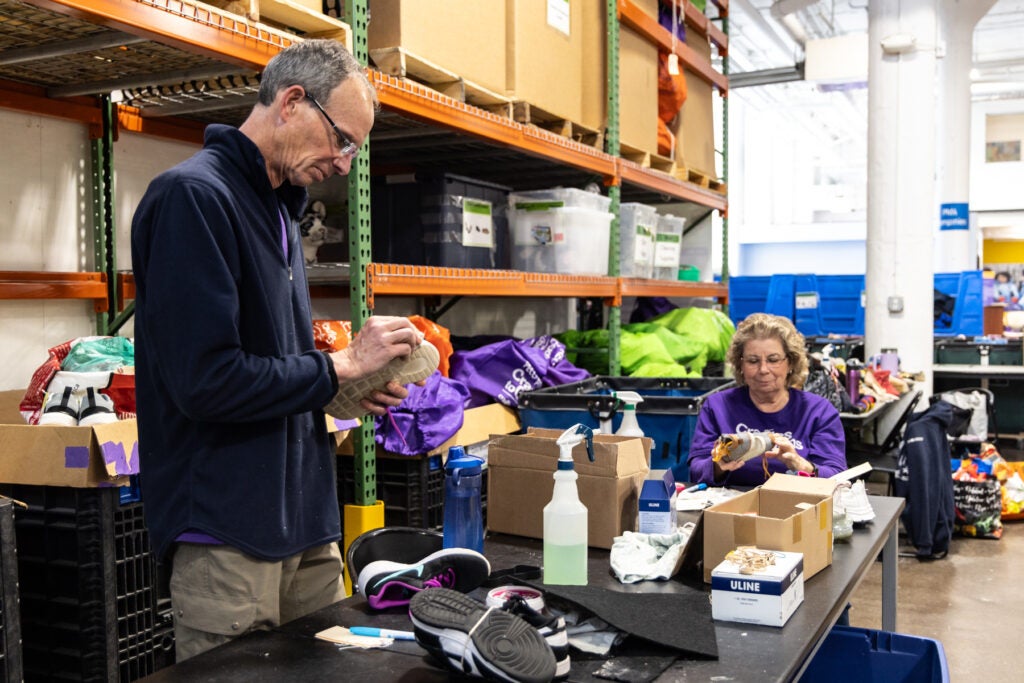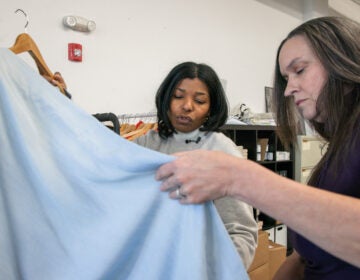Philly volunteers are fighting textile waste for Earth Month — 1 clothing bin at a time
Millions of tons of fabric waste are sent to incinerators or landfills every year, where they can release climate-warming greenhouse gases.
Listen 1:20
Longtime Cradles to Crayons volunteer Joan Craver cleans shoes that will be donated to children in need. (Kimberly Paynter/WHYY)
This story is part of the WHYY News Climate Desk, bringing you news and solutions for our changing region.
From the Poconos to the Jersey Shore to the mouth of the Delaware Bay, what do you want to know about climate change? What would you like us to cover? Get in touch.
At a warehouse in Philadelphia’s East Falls neighborhood, volunteers sorted through large blue bins of children’s clothes, shoes and school supplies, making sure each item is free of stains or holes.
Each year, Cradles to Crayons collects hundreds of thousands of donations to help fight clothing insecurity and keep textiles out of landfills.
“All of these items are things that would probably otherwise go into landfills,” said Michal Smith, executive director, as she walked through rows of containers filled with coats, dresses and pants.
The nonprofit, with locations in Philadelphia, Chicago and Boston, said it diverts more than half a million pounds of clothing from landfills each year, and distributes 1 million packages of clothing, shoes and other essentials to children and their families.

As Earth Day rolls around, Cradles to Crayons is urging people to reduce their impact on the environment by donating unwanted, gently used items at the nonprofit’s Spring Greening Donation Drive, taking place across the Philadelphia region.
Millions of tons of fabric waste are sent to incinerators or landfills every year, where they can release climate-warming greenhouse gases, and leach chemicals and dyes into the soil and groundwater. The average U.S. consumer throws away about 80 pounds of clothing a year, according to the U.S. Environmental Protection Agency.
Meanwhile, an estimated two in five kids nationwide are in need of adequate clothing. In the Philadelphia region alone, about 28% of children live below the poverty line, according to Pew Charitable Trusts.

“For many of our kids, our clothing is the only clothing they’ll receive in a season. For many families living on minimum wage, with inflation biting like crazy now, just putting enough food on the table is tough,” Smith said. “There is so much opportunity for people to think about us around Earth Day, and provide us with clothing so that we can then turn around and give it back to kids.”
Cradles to Crayons works with more than 170 partners in the Philadelphia region, including Project HOME and the Children’s Hospital of Philadelphia, which help distribute donations.
Smith said it’s crucial the donations are in good shape. However, any item that is not suitable for donation is reused, she said.
“As you can see, they look brand new,” Smith said as she picked up a pair of pink, glittery sneakers. “Any kid’s gonna feel pretty good about putting them on. We believe that quality equals dignity.”

At the warehouse, volunteer Bill Eichner was hand-cleaning children’s shoes. The Valley Forge resident jokingly described himself and fellow volunteer Joan Craver as “cobblers at work.”
“It’s amazing, you put Spray ‘n Wash on it, or if it’s white shoes that look like they’ll never get clean, you put bleach on them and they come out looking spotless,” Eichner said. “But the key is we make sure the structure is in excellent shape.”
Eichner said he began volunteering for Cradles to Crayons in 2012 because he wanted to do something with a purpose after retiring from the “big, bad business world.”
Similarly, his fellow colleague Craver began volunteering countless hours a week after retiring in 2018.
“I feel like I’m really making a difference for these kids who need help,” said the Lansdale resident.

Smith said she wants to remind those about to begin spring cleaning that their clothes have a lot of life left.
“Look through your closets. I guarantee you, there’ll be things that you’re not wearing that a kid could wear,” she said. “But environmentally, when you think about sorting through your clothing, don’t give it away irresponsibly. Don’t put it in the trash. There are other people that can use it, and it can benefit a kid.”
WHYY is your source for fact-based, in-depth journalism and information. As a nonprofit organization, we rely on financial support from readers like you. Please give today.






